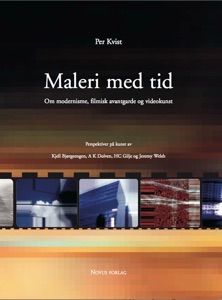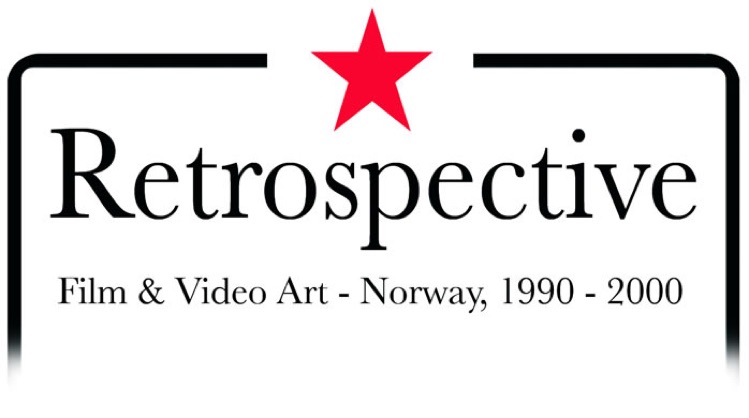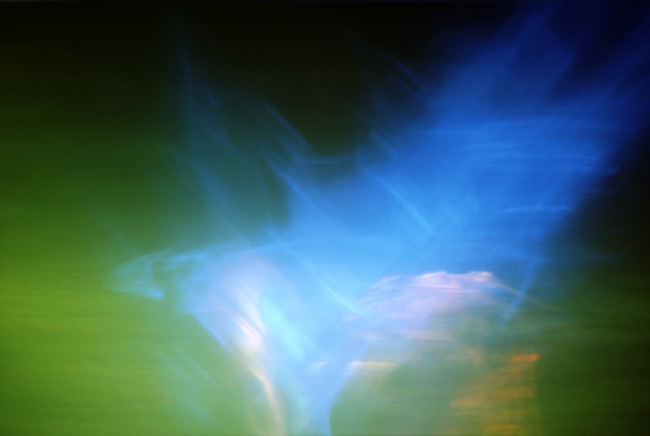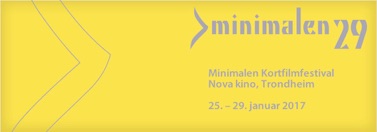Retrospective: Film- & Video Art, Norway,1990 - 2000
Utstillingen Retrospektiv: Film- og videokunst i Norge er et resultat av et forskningsprosjekt i regi av Atopia som tar for seg kunstneriske film- og videoarbeider fra 1960-tallet. Formålet er å utforske og utvikle den historiske konteksten for eksperimentell film og videokunst i Norge. Dette er første del av en utstillingstrilogi og retter oppmerksomheten mot arbeider produsert mellom 1960 og 1990.
Mange av kunstnerne i denne utstillingen er velkjente videokunstnere. Andre hører mer hjemme på kino enn i gallerier eller museer. Noen av filmarbeidene har aldri før vært plassert i en museumskontekst. De er likevel bemerkelsesverdige verker som hovedsakelig ble laget for kino på 1960- og 1970-tallet. Kjent som “frie kunstneriske kortfilmer” er de nært knyttet til samtidskunstneres filmatiske verker. Som dokumentararbeider er de kompromissløse i sine synspunkter, filmatiske stil og tilnærming, og som kortfilmer faller de utenfor den narrative produksjonsstandarden.
Utstillingen består av 64 filmer og videoarbeider av 36 enkeltstående norske kunstnere foruten ti videoportretter fra 2010 og 2011.
An exhibition opening and book launch:
Maleri med tid
Painting with Time
by Per Kvist
with works by:
Kjell Bjørgeengen
A K Dolven
HC Gilje
Jeremy Welsh
Maleri med tid – Om modernisme, filmisk avantgarde og videokunst
(Painting with Time - On Modernism, Avant-Garde Film and Video Art)
Painting With Time is part of Atopia’s “Retrospective: Film & Video Art, Norway” project. This is a project for in-depth examination of the historical development of artists’ film and video works in Norway. Initiated in 2007 it is a long-term research project of Atopia that aims to create new historical visions and approaches surrounding artists’ film and video works.
Through Painting With Time Per Kvist writes a new version of the history of Visual Arts and the Moving Image. Kvist approaches the works of Kjell Bjørgeengen, A K Dolven, HC Gilje and Jeremy Welsh in the light of Modernism, Avant-garde Film and early Video Art. The book is anchored in an idea about historical repetition, at the same time exposing how we encounter the past with the influences of our own time. An important proposition is related to the idea of musicality of the image and modernism as an impure visual phenomenon. Here we can even talk about a “musicalisation of visual art” in the 20th and 21st Century. In the understanding of media, it becomes evident that these can be viewed in the light of ideas about the specific and mixed media, but also the shifting state of media. Media are alive and in a state of constant change. They seem to endure, preserve and absorb the past into the present time. They act creatively and give space for new specificities in a movement towards the future.
Per Kvist (born 1965) is an art historian and writer focusing on the visual arts and moving images. Kvist is a former Dean at Bergen Academy of Art and Design and leader of Tromsø Kunstforening. For many years he was a member of Arts Council Norway, where he chaired the Board for arts and crafts. Kvist is currently Dean of the Faculty of Fine Arts at the University of Agder and Chairman of Kristiansand Kunsthall.


Book & Hedén - Cathrine Constanse Gjelsnes – Inger Lise Hansen
Mattias Härenstam - JetZet Film - Ingebjørg Torgersen
This exhibition takes as its point of departure the idea that art and social-political developments are intertwined in a mutually reinforcing ebb and flow of inspiration, reaction and reflection. It draws on the Latin term prōpellere meaning “to drive forth or onward, to push or urge forward”.(i) The propeller churns up the tranquil surface of society, and the maelstrom created in its wake has ripple effects in the deep waters where artistic reflexivity resides. What emerges from the depths may be complex and ambiguous, but its potential interpretations can create new insights into how we might view the world.
The Propeller exhibition at Atopia features moving image works made by artists based in Norway in the 1990s. This decade saw a number of changes take place in Norwegian society, giving rise to issues that can be traced in the works on display. The viewer contributes – as Duchamp argued – to the creative act the work, and each work in the exhibition can resonate with a number of different aspects of the 1990s.(ii) Each person will have their own recollection of the period: it is near enough for the memories to still be fresh, though not sufficiently removed to create a sense of nostalgia for a time past.
Two events in the 1990s put the Norway’s sense of self under the lens: the 1993 EU referendum and the 1994 Winter Olympics. Both presented opportunities to show what the nation stood for, its history, idiosyncrasies and future paths, and contributed to the stereotype of a land of farmers, fishermen, stunning landscapes and healthy living. This glossy portrait did not include rising tensions between left and right-wing extremists, profound concerns about the continued fall-out of Chernobyl and greater levels of pollution, the fact that Norway had the highest number of drug overdoses in Europe, or the growing reliance on oil and gas export, leaving other industries decimated.
The propeller thematic is also reflected in the design for the exhibition, in which the moving image works are displayed on monitors, mounted in a circle, with partitions between them, intended to draw visitors in to the intimate space of each work, before propelling them onto the next each screen. The different pace, nature and feel of each work together create a visual and sonic cacophony, indicative of the complexity of social development - from the aspects that are heralded as uniquely positive to the darker sides of ‘progress’. It is hoped that the texture of the exhibition combined with viewers’ own recollections of the era, can create fleeting instances of polyphony, bringing different moments of the recent past into focus.
Ingrid Book & Carina Hedén’s What is spade culture actually all about? (2000) 66 min. Book & Hedén’s depiction of idyllic, bucolic setting in Sweden (Hedén’s native country) from which the artists gathered wild plum trees for an allotment garden in Malmö, which was later destroyed to enable housing development. Patience and a meticulous approach to farming dominates the pace of the film: the camera dwells on branches, leaves, and the wind rustling through the fruit trees, and resists the temptation to speed up to comply with the conventions of the documentary film genre. The work instead takes on a performative dimension, enacting the slowness and detailed approach of the process it depicts.
Inger Lise Hansen’s Static (1995), 04:26, was originally shot on 16mm film. Her work uses stop-motion technique to animate different objects found at varying locations in the US, UK and Norway. The soundtrack is made up of ambient noise and static electricity, which compounds the emotive qualities of the time-lapse photography to create different vignettes of decay and destruction. The found objects or rubbish at various locations show natural landscapes battling the gradual build-up of debris, while the sweeping views of cityscapes suggests that the ever-expanding urban realm will gradually swallow up what is left of a relatively untouched nature.
Cathrine Constanse Gjelsnes’s video Bærtur (1998), 04:45 min (no sound) depicts a tranquil forest scene, in which some people are picking berries. The actors portray drug addicts, but their condition is not immediately apparent, not until one notices their staggering gait, which is woefully unsuited to the uneven terrain, and jars with the pleasant scenery. Originally conceived to be shown at the Jazid club in Oslo, the berry-swapping scene highlights the absurdity of the drug addict’s existence – the constant foraging for the next hit –underlining the ultimate pointlessness of the transaction.
Ingebjørg Torgersen’s Tur-Retur Hit (1989) 5:42 (originally shot on 16mm film) shows a number of different people waiting for the train at Oslo’s Central Station. The soundtrack enhances certain aspects of the video’s ambient noise and the composition of scenes creates concentrated vignettes of intimate human behaviour. In a culture not renowned for it chattiness, Torgersen’s film presents an accurate portrait of everyday life. The individuals depicted seem atomised, removed from the world around them: nobody converses, except for with one official when the inevitable becomes clear. Even when nobody is going anywhere, silence prevails. And humour is subtly created in the absurdity of the situation.
JetZet Film (Vidar V. Olsen, Dag Stiberg and Sverre Strandberg) with their video Herr Blau (1999) 34:09 min. (originally shot on Super 8) playfully examines the role of the artist and the 1990s leitmotif of ‘individuality’. Oil is a recurring element: from its plastic properties that can be used in art-making to its detritus, and the artists are gradually poisoned by the blue petroleum food they consume. The video’s German narrator makes pretentious statements in his pieces to camera; despite being a self-proclaimed conceptual artist, the meta-work he is making alludes to the role of the curator, as it emerged in full in the 1990s.
Mattias Härenstam’s Hverdagliv i det post-utopiske velferdssamfunnet (Regnet) (1998) 7:54 min. depicts a man in bed in a sparse room, lit by a single lamp. The sound of pounding rain is the only soundtrack. He passes the time by sleeping, masturbating, smoking and is visited by various nightmarish visions. He does not work, but lies in an apoplectic state of inaction, subject only to the bizarre machinations of his own subconscious. Even these are not enough to stir him into action, and the monster that visits him merely pads around the room before disappearing. Malaise and intransigence permeate the scene: everyday life is just one party after another, followed by the dull ache of recovery – after Utopia it always rains.
Natalie Hope O’Donnell
January 2013
------
* Still from Static, 16mm, Color, sound, 4:30 min, Inger Lise Hansen, 1995
(i) Oxford English Dictionary, Third Edition, June 2007. Online version.
(ii) Marcel Duchamp, 'The Creative Act', essay written for a lecture at The American Federation of Arts Convention in Houston, April 1957. Published originally in Art News 56, no 4 (summer 1957), pp. 28-29.
Sponsors:


ATOPIA invited Natalie Hope O’Donnell to curate the first exhibition in the series of The 90’s.
Propeller: the 1990s
17 Jan - 17 Feb 2013
With this exhibition we add a new chapter to Atopia’s investigation of the history of film & video art in Norway.
The exhibition series would also highlight various curatorial approaches focusing on this period.
ATOPIA invited Marianne Zamecznik to curate the second exhibition in the series of The 90’s.
"FORM AGAINST BACKGROUND presents five works; three films and two videos, brought together through their uses of analogy. Here forms are set into play against a background; focusing on abstraction instead of narrative; where repetition is used to visualize real or illusory transformations.
Form is here understood as having a theatrical quality — a kind of stage presence. Whether pictorial, sculptural, or architectural, it is an
integral part of ambient space. Form in these works is seen as something imitating the efficacy of a gesture; like poetry, it's possessed by the knowledge of the human body and how, in innumerable ways and moods, it creates meaning. Moving image visualizes the constant and the gestalt, against which the appearance of the form from different points of view is constantly being compared.
The psychological as theme gives form to the background of the exhibition; Metaphors for psychological states and existential dimensions such as longing for transformation, the desire to do something impossible - like flying or being able to see time in fast-forward motion. The pulsating, repetitive movements of natural forms evoke the feeling of a fundamental state of being, where one is connected with all of nature and everything on this planet, pulsating to the rhythm of a heart. (Marianne Zamecznik)
ATOPIA invited Marianne Zamecznik to curate a new exhibition about the artists film and video works in Norway 1990's.
FORM AGAINST BACKGROUND // FORM MOT BAKGRUNN
Artists:
Rolf Aamot
Marte Aas
Inger Lise Hansen
Farhad Kalantary
Tone Myskja
23.05 – 22.06.2013




© Atopia Stiftelse, 2017-

Retrospective: Film & Video Art in Norway, 1990-2000
Atopia is proud to present a program of film and video works celebrating the achievements of a decade of artists’ engagement with moving image in Norway. This is a representative program of the approaches and attitudes that artists brought to the moving image works in the 1990’s. Contributions made by 29 artists with their single-screen works make this into a significant collection. Some of them were young artists in the 90’s, fresh out of school, while others were established artists and educators of the practice. Remarkably they have all continued and flourished their engagement with the moving image in the following 20-30 years.
Atopia started this project more than seven years ago. Artists´ works were collected from around the country and three separate exhibitions were organized in 2013 with Marianne Zamecznik, Natalie Hope O’Donnell and Per Kvist as invited curators. The current program owes much to their contributions and includes many of the works they had selected. This program is the culmination of Atopia’s work on the 90’s and it brings together a wide selection of artists and art works.
The program contains single screen and short film and video works. Due to such limitations a number of important contributions to the moving image in that period made by artists such as Kjell Børgeengen, Kristin Bergaust, Lars Paalgard, Ingrid Book and Carina Hedén could not be included.
And last, but not least in the list of artists here we miss the presence of film
and installation artist Ellen Trap-Meyer, who could not bear the burden of the 90’s. Ellen and her likes were the heroes of that period.
ATOPIA is grateful to all the artists who have contributed to this long awaited project, and very thankful to Minimalen short film festival as the first screening place of this program.
Name of artists and works:
The 90’s: Program 1
Jeremy Welsh: Søndag, 8 min, 1990
Rolf Aamot: Nordlys, 10 min, 1991
Inger Lise Hansen: Talking to a Stone, 6 min, 1993
Elisabeth Mathisen: Mother Tongue, 3 min, 1993
Torbjørn Skårild, All As Nothing At All , 2 min, 1993
Dimitri Lurie: Helvetika, 2.30 min, 1995
Åslaug Krokann Berg: Hide and Seek, 1 min, 1995 & The Storm, 2 min, 1997
Knut Åsdam: Untitled Pissing, 2 min, 1995
Marte Aas: Flying Shoes For A Princess, 5 min, 1995
Ivar Smedstad: Century Fuge 255, 6 min, 1996
Pia Myrvold: Dada Memory (interactive sound composition) 2 min, 1996
Tone Myskja & Jon Balke: Compositions in Red, Yellow and Blue, 5 min, 1997
Farhad Kalantary: Unforgetting, 7 min, 1997
Cathrine Constanse Gjelsnes, Bærtur, 5 min, 1998
The 90’s: Program 2
Kjetil Skøien: Definitely Weekend, 5 min, 1998
Mattias Härenstam, Everyday Life in the Post-Utopian Welfare State (The Rain), 8 min, 1998
HC Gilje: hkmark1, 5 min, 1998
A K Dolven: I Hold Your Head in My Hands, 4 min, 1999
Jannicke Låker: Marotte, 3 min, 1998 & Spiderwoman, 1 min, 1998
Andrea Lange: Continual Shooting with Canon, 7.30 min, 1999
Leif Gaute Staurland: We are real tourists… Yes, 10 min, 1999
Mariken Kramer: Once a Lullaby, 2 min, 1999
Anne Lise Stenseth: Harvest, 10 min, 1999
Sabina Jacobsson: Destroy Allan - 1 min, 1999
Ellen Ugelstad & Alfonso Alvarez: Flip Film, 1.30 min, 1999
Trine Wester & Anneke von der Fehr: All About Attitudes, 5 min, 2000
Pekka Persson: Amomentum, 2 min, 2000
29 works
30 artists
TRT: 132 min
Curated by Farhad Kalantary
More information on the program is available on the website of the festival:


